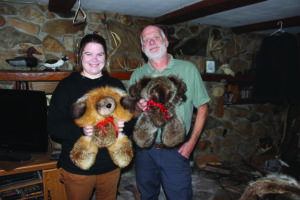
“They all look completely different,” Laura Upham said of the bears made from fur she trapped. “They all have their own personality. There’s been one or two that I really wanted to keep.”
Laura Upham recalls a particular trip she and David McClain made a few years ago to sell furs from wildlife they had trapped.
The prices for the pelts going to a wholesale trader were so dismal and had been for quite a while, it was making an Eastern Shore tradition one of their favorite activities more work than it was worth.
“We got enough to buy ice cream and gas on the way home,” Laura said. “I think that was the year we decided to get into something else.”
While they still work with their wholesaler, that something else helps better justify their efforts in trapping nuisance and overpopulated wildlife.
When their pelts come back from the tanner, they’re sent back out to a Pennsylvania crafter and turned into keepsake Teddy bears.
“It’s just a really good alternative to have and to market the fur than basically giving it away,” Upham said. “People that buy them love them.”
For McClain, who raises hogs and chickens on a 33-acre farm in Trappe, adding more value to the furs fits into what he’s already doing.
“There’s a trend nationally — small farm, buy local. I think this is just a part of that,” he said.
The bears are made in two sizes; a small one that sells for $120 and a large one selling for $200.
They’re available at local stores including Justamere Trading Post in Easton and McClain displays them at his stall in the St. Michaels Farmers’ Market on Saturdays during the season.
When the tanned hides of beaver, raccoon, fox and muskrat leave McClain and Upham’s Windy Hill Fur Co., a select group heads to the capable hands of Renee Carpenter at R&R Trading Post in Lebanon County, Pa., where she combines furs from several pelts to complete a bear.
“We make some requests but we also tell her to do her thing because she’s got a great eye for it,” McClain said.
When the finished bears come back, they are ready to become a keepsake for a family to pass down generation to generation.
McClain said first time grandparents and parents are common buyers for their bears, and some have stayed local with others winding up in far-off states like Idaho.
“They all look completely different,” Upham said. “They all have their own personality. There’s been one or two that I really wanted to keep.”
McClain had been living on the Eastern Shore since 1989 operating a small farm with chickens and hogs and was having trouble with foxes infiltrating his chicken flock.
He called in a trapper who helped McClain get set up on his own. The process and skill needed for trapping intrigued him.
“Three foxes in four traps and I was hooked,” McClain said.
Upham works as a state forester in Delaware and growing up in Vermont, she said she always wanted to be outside.
“I grew up outdoors,” she said. “I learned to hunt and fish at a young age.”
She took a trappers education class at age 12 but said she’s learned a lot from McClain and an ample supply of YouTube videos from other trappers.
“I view it as a tradition that’s important to continue,” she said. “We need to get more people involved.”
The bears help with that, they said. They’re good conversation starters at the farmers’ market, McClain said and allows him to talk about the need for trapping overpopulated species like foxes to help the area’s ecology, how other parts of the animal are used and help sustain a part of the Shore’s heritage.
“Any chance we have we show kids how we do this,” McClain said. “I jabber on to everybody about it.”




